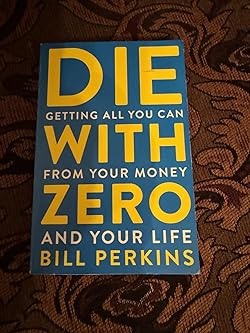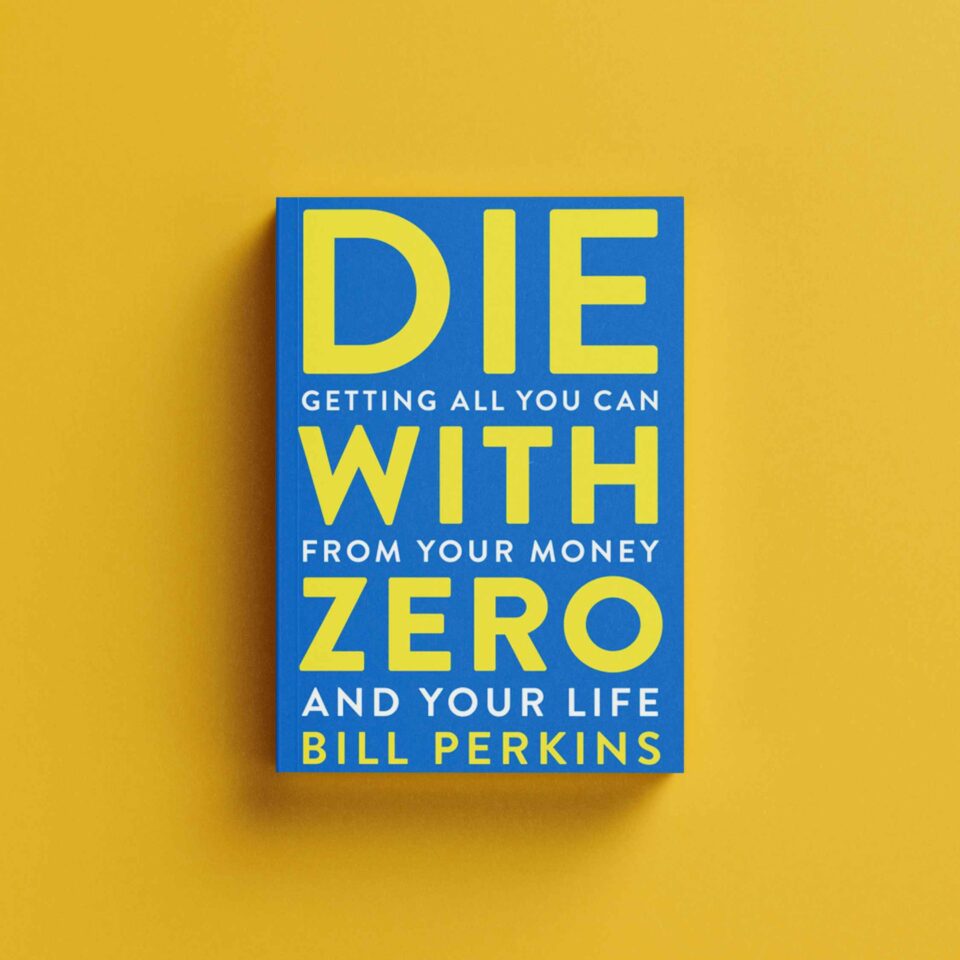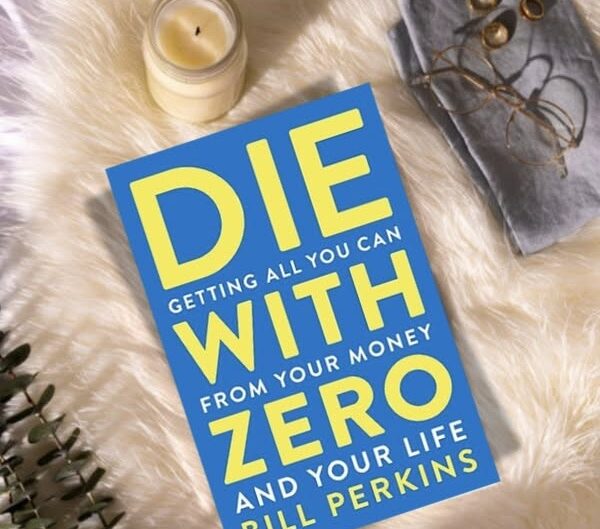When I first saw Bill Perkins‘ book ‘Die with Zero’, I read the back cover, as I do before buying every book.
The back cover caught my interest by promising a different perspective on money and life and offering a third way to optimize both at the highest level.
It became a valuable tool for me, one that I really enjoyed reading and tried to apply by incorporating my own methods.
In fact, Bill Perkins helps all of us learn how to use our savings optimally, not just for retirement years, but to experience life at every moment without risking our future.
As I summarize this book, I will also try to present you with different perspectives.
If you’re ready, let’s get started!

Bill Perkins begins his book with one of Aesop’s fables, “The Ants and the Grasshopper,” which we all know well, and he uses this story in many places throughout his book.
In the story, the grasshopper has fun all summer without working, and when winter comes, it goes hungry. The ants, on the other hand, work hard all summer and store all the necessary provisions for winter.
Bill Perkins says that this story teaches us that there is a time to work and a time to have fun, but points out that the ants don’t have time for fun because they are constantly working and gathering provisions.
He emphasizes that it is not just about working to survive, but about truly living life, and that he wrote his book to convey this message.
Optimize Your Life!
Bill Perkins begins the first chapter with the dramatic story of his childhood friend Erin’s husband, John, who was diagnosed with cancer at the age of 35.
He mentions that he suggested Erin quit her job to spend his last moments with John, and Erin had already made that decision.
And in John’s last moments they spent time together and did what they wanted.
When Erin thought about that difficult period after John passed away, she was glad that she left her job.
Thinking about such things is hard, and it is even harder to think about it for ourselves or our loved ones.
While this situation may seem extreme, it is clear that it could happen to any of us.
Bill Perkins frequently talks about death and the fact that we will not live forever.
Therefore, he teaches us to value experiences over money and how to optimize our lives to have as many experiences as possible.
Even though it’s hard to think about death, death is a very powerful trigger.
One of the triggers I have written on the board above my desk is to remember death.
Of course, just remembering death can also be a source of a lot of stress.
However, using death as a frequent trigger is a very strong factor in keeping our motivation alive and maintaining momentum.
The most important thing, though, is to know what we expect from life in order to achieve the principle which Bill Perkins wants to convey in this book: “Getting the most out of life and collecting memories through as many experiences as possible,”
For this, we need to brainstorm a lot about what we want and especially why we want it, to uncover our passions and expectations from life.
At the end of the first chapter, Bill Perkins advises us to think about the life experiences we would like to have and how many times we would enjoy having them.
This recommendation helps us take the first step in uncovering our passions and expectations from life.
Invest in Experiences!
When you read about Bill Perkins’ roommate Jason Ruffo’s three-month backpacking trip across Europe, I am sure you’ll be daydreaming 😊
It’s something most of us would love to do 😊
I did a smaller version of this with a childhood friend who was doing Erasmus in a different country at the same time as me.
We planned a trip and visited Budapest, Vienna, Bratislava, and Barcelona in seven days.
We only stayed one night in a hostel with an eight-person room in Bratislava.
The other nights, we slept on the streets, in airports, at a Turkish kebab shop in Budapest, in train stations, and bus terminals, if you can call that sleeping 😊.
It was truly an incredible experience for me, one I could only have had at that age.
Now, at 36, despite many people telling me not to do Erasmus, went to a tiny city in Hungary for the program and then having this experience left a very strong memory in me and now I say I am glad I did it.
Looking back at the photos and reliving those moments is an incredible feeling for me 😊.
In this chapter, Bill Perkins emphasizes that we shouldn’t waste our lives constantly working and thinking about retirement but should start living our passions early on—right now!
He states that life is the sum of all experiences and shows how to create this sum not metaphorically but by assigning numerical scores to experiences and graphing them.
In other words, it allows us to score the pleasure we get from each experience, like the points earned in a game, and to add them up over the course of a year to see our experience points for that year.
And by graphing them, we can see your experience scores over the years.
This way, we can see our experience scores for each year and compare different experiences to choose the best ones.
Additionally, Bill Perkins points out that experiences are a form of investment.
When we think of investment, we usually think of stocks, gold, crypto, real estate, etc.
However, we also invest in our children or loved ones, and most of us don’t think about whether there will be a financial return.
Investing in experiences is similar; even if there is no financial return, it remains a lasting profit in our memory throughout our lives.
Bill Perkins calls this “memory dividends” and encourages us to think about how we can increase our memory dividends.
Why Die with Zero?
Bill Perkins discusses how living on autopilot can prevent us from living our passions and leading a determined life.
He illustrates this point with the story of his friend John Arnold.
Despite being very successful in the energy trading business, John disliked his job so much that he told Bill Perkins, “If I’m still trading after I make $15 million, punch me in the face.”
However, John continued trading even after reaching $15 million and only quit when he reached $4 billion at the age of 38.
This age might seem early, or you might think it was worth it for that amount of money.
However, Bill Perkins notes that John can never go back to being 30, can’t reclaim the years he missed his children’s early childhoods, and couldn’t spend $4 billion in his lifetime even if he tried.
He adds that John didn’t need to stop at $15 million, but he could have found the optimal time to stop earlier and spend his time on experiences that would provide higher “memory dividends.”
And imagine the amount of valuable time he has wasted to earn that money.
So if we don’t die with zero, the time spent earning the leftover money will have been wasted.
Of course, you may love your job. But none of us, even if we love our job, would want to spend 24/7 at work.
Fort his reason, even we love our work, we need to find areas outside of work where we can have different experiences and make time for them.
However, many people are most concerned with what they will leave for their children.
Bill Perkins gives a brief answer to this in another chapter: Why do you want to give your children something when you die rather than while you’re alive?
This perspective resonated with me as well.
I also save for my son and until reading the book I planned to give him the savings at 18 and let him take charge of his own finances.
After reading this book, I’ve reconsidered this plan, and Perkins explains the reasoning in later chapters.
In this chapter, Bill Perkins presents another very striking data: Studies in the United States show that despite saving for retirement, people continue to save even at the age of 70, and their savings keep increasing.
And these savings are mostly for potential high health and care expenses.
Perkins recommends insurance and emphasizes the importance of regular check-ups, a healthy diet, and exercise while young to manage these expenses early.
He warns against the habit of excessive saving, which can keep us from experiences and accumulating memory dividends.
Perkins challenges us to seriously consider dying with zero!
How to Spend Your Money (Without Hitting Rock Bottom Before You Die)?
Bill Perkins begins this chapter by acknowledging that it is impossible to die with exactly zero money, and he is absolutely right.
Since none of us know the exact day we will die, it is certain that we cannot die with completely zero.
So, what solution does Bill Perkins propose here?
Perkins suggests that we should all calculate our life expectancy, similar to how insurance companies, especially life insurance, do when determining policies.
For instance, if your life expectancy is 85, you can consider adding some tolerance and plan for 90.
He then advises that we invest in experiences up to this age based on our lifetime savings.
However, Perkins also emphasizes that if our life expectancy turns out to be quite advanced, it should not affect our behavior and that we should still remember death and invest effectively in experiences.
While he does not recommend living as if today were our last day, he stresses the importance of balancing living in the moment with planning for the future.
I have also seen Tony Robbins discuss this balance in his videos.
Like Bill Perkins, Tony Robbins emphasizes the need to lead a balanced life between living in the moment and planning for the future.
I find this concept very valuable and try to apply it to my life as much as possible.
What About the Kids?
When Bill Perkins talks to people about dying with zero, he says the most common question he hears is, “What about the kids?”
He challenges us to question why we wait until we die to give the money we’ve saved for our children.
According to a survey he conducted, people see the ideal age to inherit as between 26 and 35 years old.
However, there are concerns like, “What if they spend it all right away?” or “What if they don’t use it wisely?”
People often want to maintain control, but they forget that they might regret not teaching their children about money management at an early age.
Perkins argues that the real legacy we leave for our children is the experiences we share with them.
He’s absolutely right.
None of us want our children to remember us as irritable, constantly working, not listening to them, and never spending time with them.
Our goal should be to leave a good impression in their memories, not just to leave money when we die.
Children grow up quickly, and something you did with them a few years ago may no longer be enjoyable for them now because they’ve grown and their interests have changed.
That is why spending valuable time with your child and accumulating memory dividends is more important than saving money for them.
The same principle applies to charity, says Perkins.
He shares the story of Sylvia Bloom, who passed away at 96 and quietly left an $8.2 million fortune to charity.
Sylvia Bloom lived frugally and amassed this fortune, but Perkins questions why she chose to give it away after her death instead of while she was alive.
By donating during her lifetime, she could have lived a more fulfilling life and many different people in need at the time would have benefited.
Therefore, Bill Perkins emphasizes that “Your legacy is in the moment” and “Charity doesn’t wait.”
Balance Your Life!
Bill Perkins starts this chapter by recounting how, when he first started working, he saved rigorously and behaved frugally.
His boss, Joe Farrell, called him “stupid” for saving so much at a young age, which sparked a change in him.
After that comment, Perkins admits he became excessively spendthrift, spending money recklessly and without balance.
In this chapter, Perkins warns us to invest in experiences that we genuinely expect to enjoy and to maintain this balance.
He states that saving a specific percentage of your income throughout your life isn’t necessarily wise.
Even if we don’t save much in our 20s, we can save more in our 30s as our financial situation improves.
By the time we reach our 40s, 50s, and 60s, the number of experiences we can have decreases, leading to an increase in our savings rate.
Perkins shows us how meaningless it is to live frugally in our 20s and 30s, missing out on many experiences.
The so-called “golden years” of retirement that everyone talks about saving for are not actually the true golden years.
He’s absolutely right about this.
The thought of working like crazy, saving money, and missing out on experiences and memories for the sake of those years alone is enough to stress me out.
Thankfully, I’ve thought similarly to Bill Perkins up to this point in my life.
Of course I save money and of course I work as hard as I can.
But neglecting to enjoy experiences, engage in things I love, or find time for hobbies would create much heavier burdens for me.
I’m sure many people share this perspective.
That’s why the years when we are healthy, capable of earning money, and have relatively more time are our real golden years.
Perkins also advises us not to sell our time for worthless tasks, suggesting instead that we use our money to buy time.
He emphasizes considering age, health, and money balance when deciding whether to postpone an experience.
For instance, postponing an expensive experience for a few years in your 20s might seem reasonable, but in your 40s, you might want to do it immediately due to potential health constraints.
Additionally, this chapter encourages us to think about ways to invest time or money in our health to enhance the future experiences we can have.
Start Creating Your Time Buckets!
Bill Perkins says that we all die many times throughout our lives.
The word “death” may give you chills again, right? 😊
You will see the word “death” frequently in this book, but you can be sure that he uses it in the right place and in the right way 😊
So, what are these deaths?
He’s actually talking about the phases of our lives when we undergo significant changes: childhood, adolescence, being a university student, being an independent single, being a new parent, and so on.
During these phases, we all have unfulfilled desires and things we couldn’t do.
To avoid more regrets in the future, Bill Perkins suggests creating “time buckets” for the upcoming phases of our lives, in 5 or 10-year periods.
In these time buckets, we can list the experiences we want to have during those periods and add to them whenever we want.
We can also plan to repeat certain experiences in different periods.
The key point here is to focus on our health and dreams for our lives while creating these time buckets, setting aside financial concerns.
Know Your Peak!
Reading about the magnificent 45th birthday party that Bill Perkins threw for himself is truly enviable.
He explains that a few years later he realized how right it was to have that celebration at that age.
Fort his reason, he emphasizes that postponing experiences to older ages may lead to the situation of never having those experiences at all.
So, when is the best time to stop postponing and start living those experiences?
In a previous section, I mentioned how our spending and savings vary by age and how we need to balance this over time.
But when should we identify our peak and shift our focus from saving to experiencing life more fully?
Bill Perkins suggests that in order to die with zero, we need to determine the time to stop working and saving.
He argues that basing this decision solely on financial metrics is flawed because the target amount will continuously increase.
Therefore, he recommends identifying this peak not just in financial terms but also by considering our potential spending, desired experiences, and health.
The optimal method is to set a specific age as our peak, taking into account these factors.
Perkins, through simulations with his friends, found that this peak time typically falls between the ages of 45 and 60.
After reaching this peak, we should start utilizing our savings and spending them according to our life expectancy.
Even if we love our work and want to continue, to maximize life enjoyment and die with zero, Perkins stresses that we must spend more than we earn.
I’ve noticed that many financially independent individuals, despite advancing in age and spending on experiences, still try to save.
This surprises me because they already have a substantial portfolio to sustain them, and their continued focus on saving seems peculiar.
Be Bold, Not Foolish!
Bill Perkins emphasizes the importance of seizing opportunities, especially when we have little to lose.
He particularly advises young people in their early 20s to give themselves a few years to pursue their passions and avoid future regrets.
Perkins points out that we all have many options and opportunities, and we should make decisions based on our priorities rather than fears or others’ influence.
He warns against letting our limiting beliefs and fears block our paths.
Instead of focusing on accumulating a pot of money that we won’t spend in our lifetime, he encourages us to live life to the fullest, chase memorable experiences, give our children money when they can use it best, and donate to charity while we’re still alive.
Also add that we can use his own application DieWithZero by downloading it from diewithzerobook.com 😊
This app can help users apply the principles from his book to their lives.
The main reason for starting my blog was to show people that living a fulfilling life according to their passions is possible and to provide verified techniques for doing so.
Bill Perkins has done an excellent job focusing on the financial aspect of maximizing life experiences in his book.
I’d like to conclude with an exercise from Tony Robbins’ seminars and books, which I practice daily for 10 minutes.
It helps me start the day with more energy and peace.
In the exercise, Tony Robbins asks, “What moment in your life you are most grateful for?”, “What moment in your life you are most proud of?”, “What moment in your life you felt the most love?”, and “What moment in your life your are most excited for?”
He then makes us imagine and stay in those moments.
He also suggests thinking of two or three moments for each question.
Reflecting on these moments and staying in them brings me incredible peace, and I make an effort to do this exercise every day.
Seeing the physical and energetic transformations in people during the seminar as they recalled these moments was an incredible experience for me.
I share this both because, at those moments, people focus on the memories they have with their loved ones and not on how much money they have, and because it is an important situation in terms of showing how valuable memories can instantly change our state of mind.
Wealth that doesn’t add value to our lives is meaningless.
I hope we all succeed in dying with zero and accumulating valuable memories while we’re alive!
Be full of energy! Believe in yourself! Live with passion!
Take care of yourself!





Leave A Reply